History of Howden Shops & Inns - Part One
This page is a mixture of facts, taken from such sources as the census but also of memories of people and of places. Although I hope eventually to cover all the town I have concentrated here on Flatgate and Bridgegate.
Many of the memories come from a local reminiscence group consisting of Eric Watson, Arthur Henrickson, Barry Walker, Don Gill, Pat Newstone (formerly Pat Eccles who lived at the Board Inn) and Eileen Bentley. I have transcribed them below (in italics) to the best of my ability. Memories of course can be unreliable and I am sure I have made many mistakes - I would be pleased to receive any corrections.
Have a look at the old photos page for more pictures of Howden. All pictures are available either as prints or as digital images.
See also the section of this website which refers specifically to Howden Market Place and also Irene Bancroft's memories of Howden.
Most of the information here relates to shops, trades and inns. Any additional memories and pictures to add to this history would be very welcome.
Flatgate
The Cross Keys
In the 19th century there was a beerhouse in Flatgate, kept in 1840 by William Coult, which may have been the forerunner of the present Cross Keys. William Coult had formerly been the foreman at Howden Hall.
The 1851 census records a pub called the Cross Keys in Flatgate kept by William Brown who lived there with his wife, Ruth and daughter, Ann.
The inn then probably underwent alterations as, in 1879, when the Howden Hall estate was sold, it included 'all that newly-erected, substantially built and well-accustomed Inn or Alehouse called The Cross Keys'. The landlord then was Robert Hall.
Robert Hall [1827-1891]
Robert was originally from South Duffield and by trade was a woodman. In 1853 he married Mary Taffinder Cuttill from Howdendyke. The couple went on to have eight children, seven of whom survived to adulthood. By 1871 Robert was the licensee of the Cross Keys. However he bought California Cottage and the adjoining orchard land in 1879 and his descendants continue to live and workat California Gardens today.
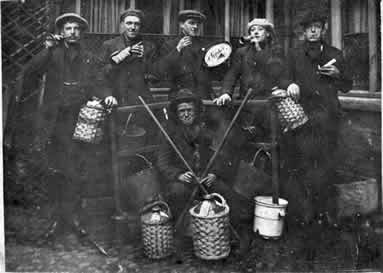
An early jug band at the Cross Keys
Changing landlords
The landlord in 1891 was William Chapman from Haldenby and in 1901 it was Herbert Markham and his young family who had come from Armley in Leeds.
The Markhams did not stay long and by 1911 John and Mary Hair, who were Scottish, had moved in with their daughter Constance.
In 1915 Constance Hair married Herbert Hall, son of John Cuttill Hall and his wife Harriet and grandson of former landlord Robert Hall. After the death of his father-in-law Herbert became the landlord of the Cross Keys and remained there until the mid thirties.
Landlord in wartime was William H. Goulsbra who married Edith Hewison. A later landlord was Reg Newham, son of H. Newham, the builder.
Fish and chips
Memories: For many years there has been a fish and chip shop at that end of Flatgate. It was Ruslakes - but it closed during the war. Eric Watson opened [re-opened?] the wooden hut 'chippy' down Flatgate when he came out of the Air Force for 6 months but couldn't get the fat or the fish. He ran it with his aunt Eva.
Batty's shoe emporium
Memories: Also at that end of Flatgate was
Mr George Batty, who was a cobbler and had a shed in his back yard.
Albert Batty later opened a shop selling shoes after the war. He
called it a 'Shoe Emporium'. It's now a big bungalow.
Mrs Todd nee Curtis had a general store, sweets etc. There is also
a house set back, now lived in by Alma Henrickson. It was Sammy
Barker's and that was a shop too.
Then there was nothing else at that end apart from the doctor's surgery at Derwent House.
Derwent House
This was built c.1853-4 for Mrs Mary Dunn (nee Bell), who was originally from Portington. She died in January 1880 aged 81.
Derwent House was then lived in briefly by the Stannard family. Robert Stannard was working on the Hull and Barnsley railway as engineer and after lodging in Market Place he rented Derwent House for his family.
Robert Stannard's son Arthur, then living at Derwent House, married in 1884 Henrietta Eliza Vaughan of York. Writing under the pen name John Strange Winter, Henrietta was a prolific author and journalist and the first president of the Writers Club (1892), and presided from 1901 to 1903 over the Society of Women Journalists.
Derwent House was the home of doctors for several years - a tradition which began when Dr John Chestnutt moved to Derwent house. He was from Ireland but in 1885 married Annie Clough of Howden. Dr Chestnutt died in 1906 and soon afterwards Dr Frank Wigglesworth came to Howden.
Dr Frank Wigglesworth [1888- 1963]
Dr Wigglesworth was born at Armley Leeds in 1888. He studied at Leeds University and qualified in 1911. He came to Howden the following year and in 1913 married Ivy Webster. Their son Frank W was born in 1914.
When the war broke out Dr Wigglesworth joined the RAMC and served throughout the war. He was awarded the Military Cross and the Croix de Guerre. A daughter Margaret was born in 1920, another son, Geoffrey in 1921 and a daughter Barbara in 1924. Dr Wigglesworth died in 1963. Both sons became doctors and Geoffrey continued to practise in Howden until his death in 1970. Dr Frank practised in Goole but continued to live in Howden.
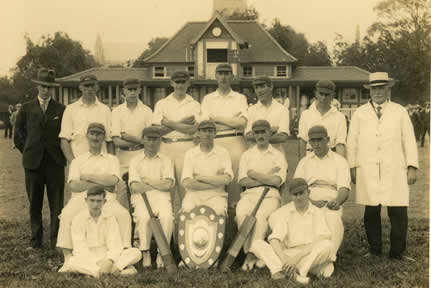
Dr Wigglesworth was a keen local cricketer. Here he is in the Ashes with a winning team.
Back from left: Basil Shaw, Les Shaw, George Ayre, Don Cooper or Roy Lapish, ? Bourne, Worley Ringrose, unknown, Fred White (umpire).
Front: David Foster, Tommy Woodall, middle with
shield Dr FrankWigglesworth, Harold Johnson, George Kemp
The two seated men at the front are unknown.
Station Road junction
Memories: On the corner of Flatgate and Bridgegate was a shop run by Edna Stead, then by Lily Thirkettle, then Mr Spivey took it over.
Station Hotel
The publican here in 1901 was John Smith but he had died by 1911 and the hotel was run by his widow Mary. She was helped by her son Charles James Chamberlain. Both he and his mother were originally from the Lake District. Charles married local girl Judith Dennis and they had two daughters Ivy Mary and Alice. Mrs Smith died in 1920. Alice married Ernest Jackson and continued to live in Howden.
A later publican at the Station Hotel was Jack Hewson who was a deep sea diver and whose diving suits were often seen hanging outside drying. His two sons Alfred and Jack established a haulage business in Howden as Hewson Brothers.
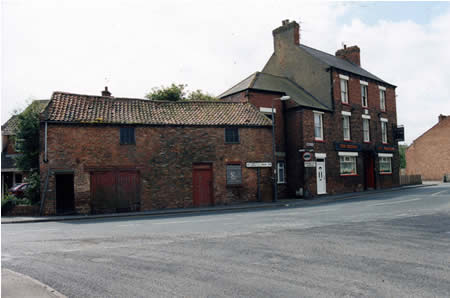
Station Hotel, Howden. The farm buildings on the left have since been converted to housing.
Memories: Next was a yard, then Joby Kirby's. Next was the registrar's, Mr Walter Horsnell. Mr Horsnell was there before the war. He was also a forage merchant. Later the registrar was Betty Welford - her house was on Hull Rd Ave.
Pies and batteries
Memories: Just after the Station Road pub is a house with a big window. After the war this was Annie Hodgson's. It wasn't a shop during the war; her shop during the war was in Market Place. She made pies. She married a Nutbrown, Mark Nutbrown's son; he was in the navy. She had a shop in that gap where Butler's was - they were good pies. She used to bake all the pies in the shop.
Then came Bob Watson - he charged batteries and accumulators. He used to sell bikes and accessories. He also stored bikes for Irish seasonal labourers.
The William IV inn/ Ringroses
The William IV inn was at 24 Bridgegate and was recorded as the William IV in 1849. Landlords included Alexander Kilham and wife Mary nee Wheldrake in 1881 and William Parish in 1892.
The landlord by 1901 was Robert Slack, originally from Belton, with his wife Deborah and daughter Maria. Deborah died in 1903 and Robert later married again to Emma Holtby, nee Foster, and they had a son Robert, born 1912. Emma died in 1919.
Frank Connell was landlord in 1921, followed by George Cutts from 1925. Mr and Mrs Cutts had a daughter Hilda who married Leslie Anderson Montcrieff. He was a member of the crew of the airship R100 and the Goole Times reported on January 10th 1931,
'Mr. and Mrs Cutts' daughter and her husband visited her parents at the William IV inn before returning to their home at Cardington'.
Sadly Hilda died in December 1934 and is buried at Howden with her father George who died within a few weeks of his daughter in March 1935. Mr and Mrs Cutts also had a son Len who was a professional boxer and had a gym in the building, as well as another son Eric.
After 1935 the William IV ceased to be an inn. For many years it has been the home of the Ringrose family who were local hauliers.
Memories: Next to Ringroses was a general store run by Mrs Wright. She was the former Irene May Matthews. Jack Wright was the postman. "Mrs. Wright was a character - her living quarters were a long way back from the shop, so if you went in and she didn't hear you and you shouted 'shop', "Alright I'm bloody coming," she'd shout."
Rex Rooke
Memories: Across the road, after the war, was Rex Rooke's electrical shop. Rex Rooke and his sister lived in Bridgegate house. Rex Rooke was a haulage contractor; he used to run cattle and animals about during the war. It was to the right of Bridgegate House. There used to be a sign saying 'Sack Hire' on the wall. Charley Spivey was behind there with his forge.
Later the shop became a small café/health food shop, before demolition.
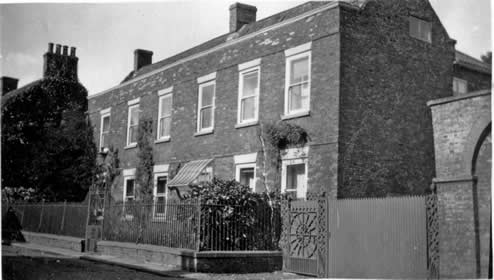
Bridgegate House as it was in the early twentieth century
Naylors butcher and wartime meat
Memories: Next you came to Naylors butchers shop. Before the war it was ? Roginsons . Mr Naylor was the butcher there in wartime.
The only thing off the ration was offal. Pat remembered that her family had had stuffed heart - they were delicious. You cooked them with sage and onion. If you got two there was enough for a family of four. The texture was like liver.
Arthur remembered that people ate sheep's heads.
Bill Walton, a local character
Another memory was that people used to eat little pigs' testicles, locally known as sweetbreads. Pat remembered old Bill Walton. He used to be a big customer of theirs at the Board Inn. He used to say to her mum, "I'm going castrating today missus, do you want any bringing back?" "No thank you," she would say.
Pat said that Old Bill Walton was a good customer. When her parents first went to the Board Inn it was a simple bar and a smoke room and under the counter there were spittoons. Her mother said, "We're not having those," and took them out. Well, Bill chewed tobacco, twist and stuff, and he complained, but without result. So after that he just used to spit in the fire.
He was working for Kays at New Fields. There he was biking away one day, late for work, when he had a puncture: "It went off like a bloody gun," he said.
Pat's dad had a cycle when they first came to Howden and it was pinched from where it was parked down the side of the pub. A couple of weeks later Bill Walton said, "Come here missus, look at this, I got it for five bob." Pat's mother hadn’t the heart to tell him it was Pat's dad's bike; he'd bought it from someone and she felt sorry for him.
Bill Walton was also a pig killer. His son, 'Young Bill', slept rough and did farm work.
Sherbournes
Memories: Next to Naylors, across the passageway was a wallpaper shop etc. which belonged to Mr Frank Asquith - Tom’s father - who was a painter. The premises are now Bullements. Frank's brother was Len Asquith who ran the newsagents in Market Place. Somebody called Farrer had the shop at one time. Mrs Farrer was a teacher and had a son George.
After that came to Sherbournes. Harry Sherbourne, who died in 1950, had a small field on Selby Road and used to grow and sell vegetables flowers, margueurites etc. He was in the Methodist choir for around 60 years.
Cussons shop
Memories: Next door was Cussons. Their original Howden shop was in Market Place. Cussons pulled the old Angel pub down to build their new shop in 1923.
The builder was Mr E Mitchell who also built the Hull Road council houses. He had a black patch on his ear. Mr S Gravill was manager of Cussons grocery shop - he had a tied house at bottom of Batty Lane.
Some of the staff at Cussons were Eric Watson and Ada, who became Ada Froude. Another of the managers was Mr. Roantree who lived down the bottom of Batty Lane in the big house. Mary Winter drove the delivery van, a Morris. George Corfield also used to drive the delivery wagon- he lived on Boothferry Rd Avenue.John Butler who later had a shop in Market Place was an apprentice at Cussons.
Another member of staff was Miss Fox, on the bacon counter.
One side of the shop was bacon, butter, etc, the other side was a general grocery – they were a high class grocers. They used to sell Passover food and stones of flour etc.
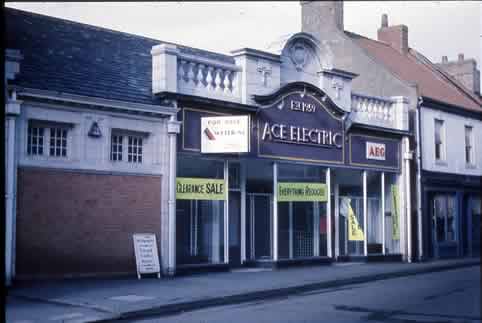
This is the former Cussons grocery shop when it was briefly an electrical store. It is now a kitchen and bathroom shop.
Bridgegate from Bishopgate corner
Now we cross the road and go back to the corner of Bishogate and Bridgegate.
Glews
Glews were on the corner of Bishopgate and Bridgegate. They were agricultural engineers and also had a large workshop next to the Bowmans, later the site of the Craft centre and now redeveloped as Minster Court.
Glews had two adjoining premises - one where garden machinery was sold and repaired. This was originally a malt house or malting flloor which ran down one side of Bishopgate. They also had a general hardware shop.
The Glews were occupying this shop in 1891 when brothers James and William were living there and being looked after by their sister Helen.
James Glew and his family were there in 1911. He described himself as ironmonger and implement dealer.
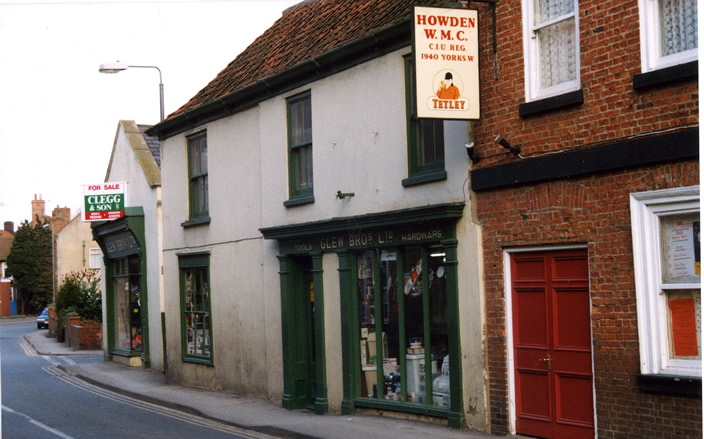
This picture was taken just before Glews closed. The building on the right with red doors is the Howden WMC.
Blacksmith's Arms / Working Men's Club
Next to Glews is the Working Men's club. This is the former Blacksmith's
Arms and once included a blacksmith's shop belonging to Edward Voase.
It remained in the Voase family for several generations.
In 1892 it was owned by Simpson and Co and the manager was Albert Burrows. The landlord in 1911 was William Goodwin.
It was sold to Howden WMC in 1919.
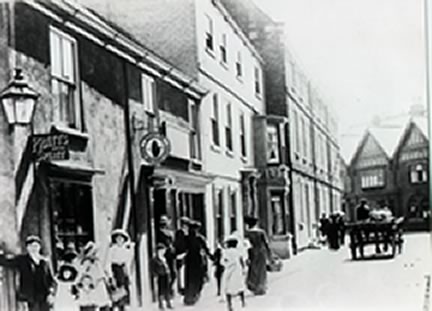
This Edwardian picture shows Glews ironmongers on the left and beyond it the Blacksmith's Arms, now the Howden WMC.
Matthews' greengrocers
Memories: Where a new shop front has recently been put in was Matthews' shop, a green grocer's. It had a bunch of artificial Fyffes bananas hanging up all during the war when nobody could get them. The hook they hung on was there till the recent work. There were three Matthews daughters - Mrs. Wright who had the shop mentioned, further up. Then there was Mrs. Grasby who was on Thorpe Rd. and Mrs Peacock who had a daughter Diana. Diana Peacock went to Miss Blackburn's school and later became a nurse.
Later the shop was run by Mrs ? Mobbs and then by Don Whitaker before he moved into the Spar shop.
Post office
Memories: Hubert Davis had the post office. His sister had a club foot. They were there during the war. Hubert called all the girls who went in 'Topsy'.
To continue reading about the shops in Bridgegate,
click here to go to part
two.
